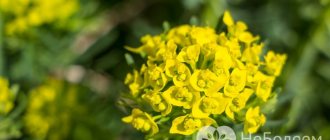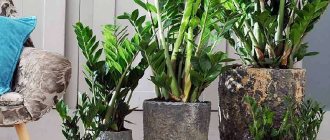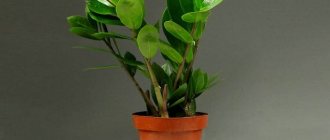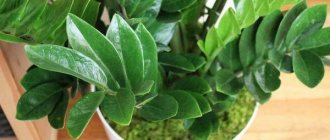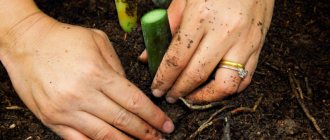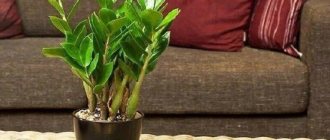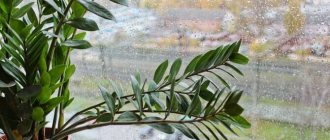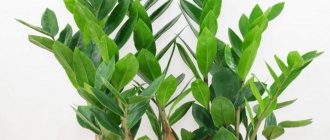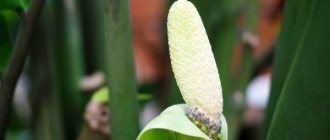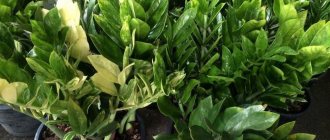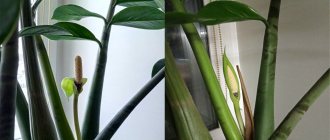Zamioculcas is a succulent that is loved by gardeners for its original appearance and unpretentiousness. Another name for the plant is Dollar Tree . Feng Shui fans believe that the plant can attract money. They are often used to decorate the window sills of offices and public reception areas.
There are many signs and superstitions associated with this plant. But before buying zamioculcas, you should learn in more detail about its beneficial and harmful properties. It is important to remember that not all houseplants are safe.
Is dollar tree poisonous or not?
For children
For young children, the plant poses a particular danger . It lies in the fact that babies tend to put things around them into their mouths. Such manipulation of zamioculcas leads to severe poisoning.
Swallowing a small piece of leaf by an adult will only lead to digestive upset. But if a child does this, he risks ending up in the intensive care unit.
This is explained by the fact that babies have not yet developed their immune system. In addition, the digestive organs do not yet contain a sufficient amount of enzymes that can neutralize toxic substances.
For cats and other pets
Pets often chew on indoor plants. If they eat even a small piece of zamioculcas, it will result in serious poisoning. Intoxication is especially dangerous for small animals .
Therefore, it is recommended to place the “dollar tree” in a place inaccessible to pets and children.
What danger does Zamioculcas pose?
Zamioculcas is considered a conditionally poisonous plant, like all representatives of the large aroid family. All parts of this plant are poisonous . The juice contained in the leaves and stem can lead to the following health disorders:
- persistent allergic reactions;
- skin rashes that closely resemble burns;
- intestinal disorders due to accidental ingestion of parts of the plant;
- visual impairment when juice gets into the mucous membranes of the eyes.
In addition, pollen from flowers is also harmful. This flower is especially dangerous for people who are prone to allergies .
The lifespan of Zamioculcas is from 5 to 10 years. The flower can reach one meter in height.
Symptoms of plant poisoning
If the dollar tree enters the body, the following symptoms are observed::
- nausea and vomiting;
- fever, seizures;
- diarrhea.
In particularly severe cases of poisoning, hallucinations and confusion may occur. Sometimes allergic reactions occur - runny nose, hives, lacrimation, rash, and wheezing. Chemical burns are manifested by redness of the skin. Getting toxic juice into the eyes leads to lacrimation, damage to the optic membrane and even conjunctivitis.
Attention! If pollen or zamioculcas juice gets into your eyes, you should urgently consult a doctor, as this may impair your visual acuity.
Zamioculcas is a symbol of female happiness and monetary profit
Fans of home floriculture have long been accustomed to the fact that green natives from distant warm countries, who have taken root in the premises of our apartments and offices, require increased attention. Despite the enormous breeding work that has resulted in the development of countless hybrids, more or less adapted to domestic conditions, these exotic plants continue to display their wild character. However, fortunately for enthusiastic florists, not so long ago - at the very end of the twentieth century, an interesting plant with a very ornate name began to gain popularity at flower auctions - Zamioculcas zamiaefolia, popularly called the “dollar tree”.
In addition to its decorative qualities, this flower captivates gardeners with its extreme unpretentiousness. What is this amazing flower? Are there many types of it? What are the benefits or harms of this flower? What is the magical energy of this plant according to the Eastern philosophy of Feng Shui and how to use it correctly?
A series of renamings
Zamioculcas zamiifolia - represents the aroid family. Unlike its fellows, it is represented by one species. The plant's homeland is East Africa. In nature, Zamioculcas has the ability to adapt to both desert landscapes and shaded moist forests. It is these beneficial properties that naturalists highly appreciate. The flower was first described in 1829 by the English florist Conrad Loddiges. The specimen he discovered was assigned to the genus Caladium and named Caladium zameilifolia, since the leaves of the plant resembled the already known flower - zamia. In 1856, the Austrian botanist Heinrich Schott classified the plant as a separate species under a new name, Zamioculcas Loddiges. At the beginning of the 20th century, thanks to the head of the Berlin Botanical Garden, Adolf Engler, the flower acquired its final name - Zamioculcas zamiaefolia. It was from this time that Dutch flower businessmen began to actively promote this exotic flower on the European market. But their efforts were crowned with success only in the late 90s of the last century. Now Zamioculcas has received a permanent residence in the interior of modern offices and apartments. What is an indoor Zamioculcas flower?
Thrifty and unpretentious
Here is a brief description of the plant. The tuberous trunk, more often called a rhizome, is almost entirely located underground; thick roots extend from it, receiving nutrition from the soil. The above-ground parts of the plant are leaves of unusual shape. The leaf is divided into 8-10 pairs of elongated feathers with pointed tips. Zamioculcas foliage can reach 1 meter in height. The base of the leaf, called the rachis, is very fleshy and thickened. The most important difference between zamioculcas leaves is the ability to accumulate moisture in the rachis and partly in the tuber, and feed on it during the dry period. The plant itself is even capable of maintaining water balance - in extreme desiccation, it sheds its feathery leaves and economically uses up the moisture reserves accumulated in the rachis and rhizome. Later, when the moisture deficit decreases, the leaves grow again from the same base. Zamioculcas reacts just as calmly to the presence or absence of sunlight. These succulent properties have won the love of even novice gardeners.
Decorative qualities
Zamioculcas is an ornamental deciduous plant. It is the lush greenery of the fleshy foliage that attracts designers, but how Zamioculcas blooms can be seen mainly in photographs, or in wildlife. The domestic “dollar tree” rarely pleases with flowers. And it’s a stretch to call this process pleasing to the eye. At the very base of the flower, a thick, inconspicuous-colored cob is formed, framed by a pale green leaf. The separate arrangement of female and male flowers in the peduncle eliminates the possibility of self-pollination.
Species or varieties?
There are several variants of Zamioculcas. However, they were not distinguished as separate species, but are considered only natural varieties of Zamioculcas.
- directly Zamioculcas zamiifolia, the most common representative in home floriculture;
- Zamioculcas lanceolata, native to Mozambique, has an elongated, lanceolate-shaped leaf blade;
- initially Zamioculcas boivinii Decne was also considered a variety, but was later classified as a different species;
- the only artificially bred hybrid, Zamicro, is a smaller copy of the progenitor, about 50-60 cm high.
- variegated (variegated) Zamioculcas has spotted foliage. The variegated version has the same basic properties and the same ease of care. Zamioculcas variegata may have white or yellowish spots along the main green plate. Due to the fact that breeding Zamioculcas is not at all difficult, recently the variegated type of flower has become increasingly widespread.
Is the dollar tree harmful?
There is an opinion that the “dollar tree” can harm its owners due to its increased toxicity. Yes, like many aroids, the juice in the leaves of Zamioculcas has some degree of toxicity. This will not cause much harm to a person, but allergy sufferers should be careful when transplanting or propagating a flower. But in homes where there are pets or stupid children, there are some complaints about this green friend. It must be kept in places inaccessible to children and animals. The harm for this category of household members is certainly not so great, but indigestion or allergic reactions are not desirable.
Chinese New Year tree, dollar tree or women's happiness?
All these unusual names indicate the popularity of Zamioculcas in folk beliefs and signs of the teachings of Feng Shui. Some associate the name “dollar tree” with the fairly high price of this plant at Dutch auctions; others actually believe that, according to the teachings of Feng Shui, zamioculcas brings profit to its owners in dollar terms. Be that as it may, the appearance of new lush green leaves of Zamioculcas for many is a forecast of income in the near future. Feng Shui strongly recommends placing the dollar tree in the wealth zone - the far left corner of the room. The Chinese consider these home flowers to be a mandatory attribute of the New Year's interior according to the eastern calendar.
Despite the fact that there is a generally recognized “female happiness” - spathiphyllum, zamioculcas is also credited with the ability to attract stray female happiness into the house of an unmarried girl. But here one additional feng shui condition comes into force - this very feminine happiness is attracted only by a blooming specimen, and since home flowering of zamioculcas is a rather rare phenomenon, the chances of a joyful change in a woman’s destiny are scanty. This may be why, in some Feng Shui interpretations of flower symbolism, zamioculcas is a flower of celibacy.
It’s up to you to believe or not to believe in such signs, but if you are still an active follower of Feng Shui, then you should remember that all the benefits of the energy of this flower are manifested only when it is given from the bottom of your heart by a kind person. Feel free to accept evergreen zamioculcas as a gift and give it to your loved ones for monetary or feminine happiness!
jplant.ru
What to do if a child ate a flower?
The first thing you need to do is call an ambulance . After this, it is necessary to rinse the stomach. To do this, give a weak solution of potassium permanganate to drink. You need to rinse until the liquid from the stomach becomes clear and free of impurities.
The poisoned child is also given an absorbent. The most suitable ones are Enterosgel or Smecta. They envelop the walls of the stomach and prevent toxins from being absorbed into the digestive organs. The victim is then given a large amount of water or sweet tea.
Children under 5 years old can only have their stomach washed in a hospital.
Could it be fatal?
Fatal poisoning may well occur if the following conditions are met:
- Man has eaten too much of this vegetation.
- Parts of the zamioculcas were eaten by a small child who is light and has weak immunity.
- The victim has some chronic diseases.
A fatal outcome is possible only if first aid is not provided on time . This can happen if parents self-medicate and do not go to the hospital.
Precautionary measures
To prevent Zamioculcas from harming the health of others, it is recommended to adhere to the following rules :
- When cutting and replanting indoor crops, you only need to wear gloves. At the same time, do not touch the eyes and open areas of the body.
- After procedures with the flower, wash your hands with soap, more than once. Wipe your hands dry, preferably with a paper towel, which should then be thrown away.
- Place the dollar tree pot away from children and pets.
- If there are allergy sufferers in the house, it is better to avoid Zamioculcas altogether.
Zamioculcas is not called the dollar tree for nothing. This plant can attract good luck in financial matters. But at the same time, you should be very careful when handling culture so as not to harm yourself and others.
Signs associated with Zamioculcas
Many people know Zamioculcas under the interesting name “Women’s Happiness”. As popular rumor goes, it is this flower that somehow magically contributes to women’s happiness. But in order for this magical property to manifest itself fully, certain conditions must be met:
- The flower must be given as a gift.
- The magical properties appear only during the flowering period, and it blooms oh so rarely.
If you believe the same superstition, as soon as this succulent blooms, happiness will immediately knock on the house, and not just any kind, but a woman’s.
Another name for the flower is dollar tree. According to the teachings of Feng Shui, this flower is capable of attracting financial well-being into the home, just like the Crassula . But if the latter needs to bury coins in a pot to attract money, then Zamioculcas can simply be placed in your home.
Flowers that cause allergies
Even house flowers that bloom beautifully on the windowsills of many apartments can be dangerous. This usually becomes clear when, when pruning or replanting, the plant secretes caustic juice from the cuts, which begins to corrode the skin on the hands.
Aglaonema
A houseplant with beautiful green leaves with white spots on the surface. It belongs to the decorative deciduous species, the flowers are small, dim, collected in inconspicuous rosettes.
Aglaonema contains poison in its leaves. May irritate skin, cause allergies, burns. But the berries formed after flowering are especially poisonous. If it enters the gastrointestinal tract, it causes severe intoxication, elevated body temperature and dehydration.
Geranium (pelargonium)
This plant has been grown on apartment windowsills for many years. It blooms beautifully with pink, red, burgundy flowers, the leaves have an original shape. This perennial feels good not only indoors, but also in open ground. Widely used to create traditional medicines and to repel insects.
The leaves of the flower emit vapors that enter the lungs when inhaled. These vapors contain essential oils, which can cause an asthma attack in allergy sufferers. When parts of the plant enter the body, poisoning occurs.
Monstera
A beautiful ornamental crop with an original flower-veil, inside of which there is a large spadix. It reaches enormous sizes, so it is often grown in floor pots not only in apartments, but also in offices. Monstera is especially loved by flower growers for its original carved large leaves.
Almost all species are not poisonous; only a few varieties contain caustic substances that, if eaten, can cause burning and irritation of the intestines. In rare cases, the plant causes reactions in the presence of individual sensitivity in humans.
Spathiphyllum
This beautiful bright flower with a white bud-veil and yellow cob, glossy large leaves has a second name - “female happiness”. It is credited with many magical as well as medicinal properties.
The plant is considered poisonous; the leaves and soft stems contain oxalic acid and calcium oxalates, which irritate the mucous membranes. If it comes into contact with the skin, stomach, mouth or eyes, the juice causes burns and irritation. If it gets into the lungs, it makes breathing difficult, which can cause an attack in asthmatics.
Scheffler
An ornamental plant with interesting umbrella leaves belongs to the Araliaceae family, like ivy and ginseng. 18 species are known. Tropical exotics today are grown indoors. Depending on the conditions, it can grow as a lush bush or a bonsai tree; thanks to its flexible woody shoots, it is suitable for weaving.
The berries and leaves are poisonous, but for severe intoxication you need to eat a lot of parts of the plant. In direct contact, shefflera juice can cause damage to the mucous membranes of the eyes or intestines; it is dangerous for the skin if there are wounds, scratches or abrasions on it.
Fatsia
The flower belongs to the Araliaceae family. It is an evergreen crop, growing mainly in the tropical regions of the Far East. It has beautiful wedge-shaped leaves, grows in the form of a tall shrub, reaching a height of 1.5 m. It is often used in landscaping garden plots, but fatsia is also grown indoors.
It is a mildly poisonous species and does not cause death, but may irritate the stomach when eating leaves, flowers or berries. With timely rinsing and taking an absorbent, the symptoms quickly disappear.
Ficus
A beautiful evergreen plant with original ovate-shaped leaves. Now it is grown in offices and apartments, valued for its unpretentiousness and variety of varieties.
The leaves, petioles and shoots of Ficus elastica contain milky sap containing 40% rubber. Allergic reactions may develop on unprotected areas of the skin, burns and blisters may appear.
When working with any poisonous crops, including those potentially hazardous to health, you need to use gloves, a protective mask that will cover the respiratory tract and nose, as well as long sleeves, making sure that the juice does not get on the skin
After finishing work, it is important to wash your hands and face thoroughly with soap.
Handsome Zamioculcas: 10 advantages of an exotic plant in your home!
It’s hard not to stare at this plant: glossy dark green leaves, fleshy, tuberous rhizome, powerful, up to 150 cm high. This beautiful indoor plant, originally from distant sunny Africa, is popularly called the dollar (or money) tree.
So, he will list the properties of Zamioculcas that make it an indispensable plant in your room.
- According to the teachings of Feng Shui, the dollar tree is able to attract finance. To lure money, you need to choose a place for the plant in the southeast (in the wealth sector) and activate the talisman by burying a couple of coins in a pot of soil.
- Adaptation of the “money” plant to new conditions will not take much time; the period of adaptation is from 2 to 3 weeks. After waiting these days, they undertake transshipment, if necessary.
- Zamioculcas loves plastic pots that are cheaper than ceramics (the plant prefers close quarters and ceramic products are not suitable due to the hardness of the walls). The ideal choice is a pot of medium height, not too loose in width. Narrow and tall will not work.
- There is no need to replant very young plants; this can only harm them.
5. The green beauty is undemanding when it comes to soil; it thrives in a mixture of turf, leaf soil, and sand (proportion 1:1:1). The bottom of the pot needs drainage - a fraction of expanded clay (diameter 10-20 mm), which is sold in any flower shop.
- Zamioculcas is transplanted into a slightly larger container no more than once a year if necessary. The plant itself will tell you whether it is necessary to replant. If the plastic pot begins to change its shape under the influence of the plant’s mass, it’s time to get down to business. During transshipment, the earthen ball is protected, and the prepared soil mixture is taken in the amount necessary to fill the volume of the new pot.
- Keeping track of a houseplant that attracts money is not difficult. Even beginners can cope with the care! Excessive humidity and stagnation of water in the soil are harmful. When watering, drain excess water from the tray. Water the plant in the warm season, focusing on the drying of the soil, and in winter - no more than once every two weeks.
- Finding where to place a pot of Zamiocúlcas in the house is always easy: places with low air humidity and partial shade are quite suitable, although for best growth they require enough light (but not direct rays of the sun). In the summer, the dollar tree can generally be kept in the fresh air - on the balcony or veranda.
- You don’t have to fertilize the plant often: no feeding is needed in the autumn-winter period. Fertilizers will be required from the second month of spring to September (take funds for cacti or succulents).
- Zamioculcas responds gratefully to spraying. Wipe the dust off the leaves periodically and you will have an incredibly beautiful tropical plant in your home - bright, green, glossy.
When performing work, do not forget to wear gloves, because the plant is poisonous! Make sure that there are no spider mites, avoid dampness and low temperatures.
And the zamioculcas, in gratitude for its care, will attract financial well-being to the house and every day will delight the eye with its picturesque, decorative appearance.
woman-page.com
